The Wiki for Tale 7 is in read-only mode and is available for archival and reference purposes only. Please visit the current Tale 11 Wiki in the meantime.
If you have any issues with this Wiki, please post in #wiki-editing on Discord or contact Brad in-game.
Difference between revisions of "Guides/River Plains Gem School"
| Line 24: | Line 24: | ||
Practice Session 1: | Practice Session 1: | ||
| − | * ROTATE the gem on the Z coordinate first. The + and - signs will switch the rotation one way or another. | + | * ROTATE the gem on the Z coordinate first. The + and - signs will switch the rotation one way or another. Four rotations brings you back to the beginning. |
| − | + | * Now try the Y coordinate. The gem will FLIP towards you (-) or away from you (+) if you are facing Cutting Disk 1 at the front of the table. | |
| − | * Now try the Y coordinate. The gem will FLIP towards you (-) or away from you (+) if | + | * Finally, try using the X axis. The gem will TWIRL either clockwise (+ -check) or anticlockwise (-) around the middle of the front face. |
| − | |||
| − | * Finally, try using the X axis. The gem will TWIRL either clockwise (+ -check) or anticlockwise (-) | ||
| − | |||
It's easiest to view the table while using the Explorer's Camera (F6) or Builder's Camera (F7). Adjust your distance and viewing angle until it feels comfortable for you. | It's easiest to view the table while using the Explorer's Camera (F6) or Builder's Camera (F7). Adjust your distance and viewing angle until it feels comfortable for you. | ||
Revision as of 10:17, 27 July 2016
|
|||||
- Located at 1558,2900 in RP
- The majority of this guide is taken from T6 and earlier, with thanks to the original authors. Updates for T7 will progressively be made!
Overview
Sections of Cuttable Gems are sliced away on a Gem Cutting Table until the result matches a target design in the Gem Catalogue. At that point, the cut gem may be removed into your inventory.
Nonstandard shapes may be saved in a Specimen Case (available with some multi-month pre-paid packages). Each case holds one cut gem. The contents of the specimen case may later be loaded onto a table for additional cutting.
In the absence of a specimen case, cut gems that don't match a Gem Catalogue entry must be discarded.
Positioning the Camera
Some players prefer to stand inside the table while cutting. However a good stance to begin with is to the right of Sanding Disk 1, in F6 view. Some players prefer to stand by the pole, with the camera rotated so it is on the rear right of the table. Others prefer the pole on the rear left, so the camera is looking at the face of the gem that will be sliced off by Disc 1. For some cuts you may want to change the camera angle to check on what is going on!
Using the Axis Controls
Getting used to the interface will make your gem cutting life easier. It does come with practice. Start by loading a cuttable gem. The option will come up when you click on the gem cutting table with a cuttable gem in your inventory. Pin the menu for reference.
Practice Session 1: * ROTATE the gem on the Z coordinate first. The + and - signs will switch the rotation one way or another. Four rotations brings you back to the beginning. * Now try the Y coordinate. The gem will FLIP towards you (-) or away from you (+) if you are facing Cutting Disk 1 at the front of the table. * Finally, try using the X axis. The gem will TWIRL either clockwise (+ -check) or anticlockwise (-) around the middle of the front face.
It's easiest to view the table while using the Explorer's Camera (F6) or Builder's Camera (F7). Adjust your distance and viewing angle until it feels comfortable for you.
Eventually you may want cut gems using the hotkeys, but it makes sense to become familiar with the way the gem and cutting blades work first.
Cutting the Gem
There are three sanding disks. Each disc works in a different plane, and will remove 1 layer of solid gem each time you use it.
Disc 1 works in the vertical axis (90 degrees). Only using Disk 1 will make cubes and rectangular box shapes. Disc 2 works on the edge to edge diagonal (45 degrees to Disk 1). Using only Disk 2 will make diamond shapes, sometimes with interesting edge patterns. Disc 3 works on the corner to corner diagonal. (45 degrees to Disk 2) Using Disk 3 also creates diamond shapes, but in a different orientation.
All you need to cut a gem is one or a combination of these disks to create a predetermined shape, as listed in the gem catalogue. The goal is to sand a gem into one of a number of predetermined shapes. The gem catalog will display a sample gem atop the pole on the table, as a reference.
Making the most of Flaws
All cuttable gems have flaws, in an endless array of random configurations. Most types of cut gem can only be formed by taking advantage of flaws in the gem. For example, the "eyelet" cut requires a flaw two layers deep, surrounded by unflawed gem. The "full eye" cut is harder, requiring a three-deep flaw. Before starting to cut any gem, examine it carefully to see what can be made from it. It is MUCH more economical to look first to see what is in the gem and take advantage of what you have than waste precious cuttable gems by going for only what you need. The rarest sets of flaws might just come up, giving you a chance at a Dragyn's Eye or Full Aidenn Mask, and those chances are not to be missed!
Sculptors sometimes say that they see the statue hidden within a block of stone, and cut away all that is not a part of it. This is exactly how gems are made: The desired cut gem is hidden within the rough stone. Sand away all the bits that are not what you want.
When you have produced an exact match for a cut gem, rotate the gem so it matches the catalogue example and complete the cut by selecting the type of gem you are making from the "finished cutting" menu of the cutting table. If your gem is an exact match for the sample in the catalogue, it will be removed from the table.
Some gem cuts require flaws that are present in only a small fraction of rough gems. Zomboe, an expert gem cutter, has provided this list of rare cuts: Tiki Mask is insanely rare. Others, in approximate order of decreasing rarity, are King's Tomb, Unity, Bridge, Lotus, Ring, Dragyn's Eye, Full Aidenn Mask, Ra's Lantern. If you find a rough gem with the right flaws that can be cut into one of these, it's usually best to do it even if you're currently looking for something else - you'll be glad of it later.
Cut Gem Catalogue
Feel free to replace pictures with better ones (preferably 120x120).
| Cut Gem | Carats | Instructions | Rarity | Uses | |
Aidenn Mask |
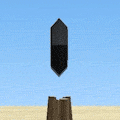
|
15 | Two flaws next to each other with solid gem on the outside edge. To cut, use Disk 1 to cut away excess from the front and back of the flaws, then use Disk 2 to cut the angled edges. | Rare | |
Amanti |

|
11 | None | All | 1 Cut Garnet: Amanti for Test of the Windsong
1 Cut Turquoise: Amanti for Test of the Windsong <Varying Amounts> Garnet: Amanti for Test of the Covered Cartouche |
Amunet |
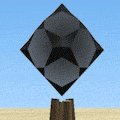
|
46 | a sphere of unflawed gem radius 5? | ||
Appolonia |
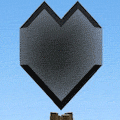
|
21 | One flaw with a large area of unflawed gem on one side of it | All | 1 Cut (Any Gem): Appolonia for Test of the Windsong |
Bastet |

|
11 | A two-deep vertex flaw | All | |
Bridge |

|
14 | A pair of two-deep vertex flaws directly opposite each other | Ultra-rare | |
Cat's Eye |
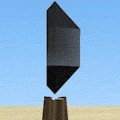
|
28 | A two-deep vertex flaw surrounded by a double ring of unflawed gem | Rare | |
Choronzon |
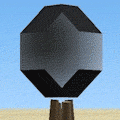
|
43 | A 5x5x3 block of unflawed gem | Common | |
Corner Heart |
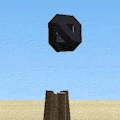
|
4 | Very small unflawed area | All | |
Crater |

|
9 | A pair of Three-deep flaws intersecting. | very rare | |
Dalessi |
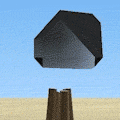
|
25 | None | All | |
Dragyn's Eye |
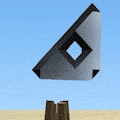
|
17 | 2 aligned flaws on adjacent faces | Rare | |
Eyelet |
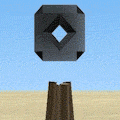
|
16 | A two-deep vertex flaw | Common | |
Full Aidenn Mask |
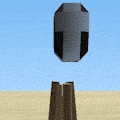
|
21 | Parallel two-deep vertex flaws with a one-deep flaw between and below them | Ultra rare | |
Full Eye |

|
24 | A three-deep vertex flaw | Rare | |
Hexas Plate |
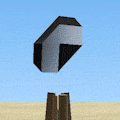
|
9 | One-deep vertex flaw | All | |
Hile's Chevrons |
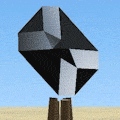
|
25 | Unflawed plane | All | |
Khufu's Ship |
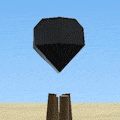
|
22 | Double-width one-deep vertex flaw | Uncommon | |
King's Tomb |
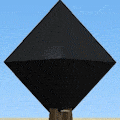
|
43 | Single flaw surrounded by double ring of unflawed gem | Ultra rare | |
Lens |
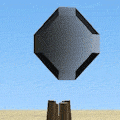
|
12 | None | All | |
Looking Glass |
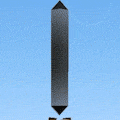
|
24 | A 6x4x1 area of unflawed gem | Common | |
Lotus |
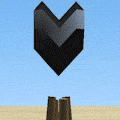
|
19 | Specific pattern | Ultra rare | |
Moorish Arch |
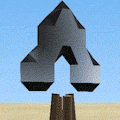
|
15 | |||
Osiris Eye |
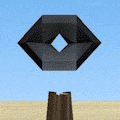
|
10 | Description: A long 3 width flaw with a 2-deep flaw in the middle. To cut, use Disk 1 to remove the excess gem from both long sides. Flip so the 'eye' is at the bottom and pointing towards the front of the table. Use Disk 2 to create a peak and reveal the central eye. Turn back around and position to use Disk 3 to cut the points at the top and bottom. | ||
Prism |

|
||||
Queen's Tomb |
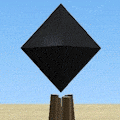
|
18 | Single flaw surrounded by a ring of unflawed gem | Common | |
Ra's Lantern |
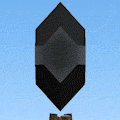
|
27 | Double-width vertex flaw, with one flaw two-deep, with unflawed gem on remaining three sides of prism | Ultra rare | |
Reflection |

|
14 | Two two-deep vertex flaws next to each other, points touching | Rare | |
Refractor |
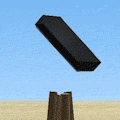
|
||||
Ring |
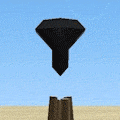
|
13 | Two deep intersecting flaws forming a T shape surrounded by unflawed gem | Ultra rare | |
Shen of Horus |
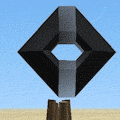
|
28 | two adjacent 3-deep flaws, surrounded by unflawed gem | crazy | |
Solarkin |

|
24 | |||
Sprocket |

|
14 | Relatively unflawed diagonal plane | All | |
Suspension |

|
9 | 2-deep vertex flaw | ||
Symmetry |
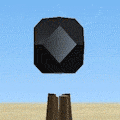
|
19 | A 3x3x3 area of unflawed gem | All | |
The Fox |
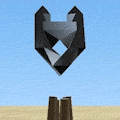
|
? | |||
The Shark |

|
8 | A three-deep vertex flaw | Rare | |
Thistle |
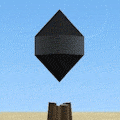
|
12 | None | All | |
Thoth's Knot |
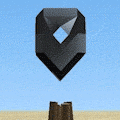
|
18 | Two lines of three flaws, crossing adjacent to one another, with solid gem beside each and 1 cell of gem above and below | Ultra rare | |
Tiki Mask |
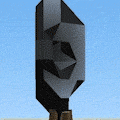
|
35 | Double-width one-deep vertex flaw | Ultra rare | |
Tombstone |

|
26 | |||
Triclops |
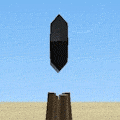
|
14 | |||
Unity |
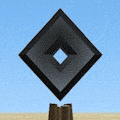
|
36 | Two-deep vertex flaw surrounded by an area of unflawed gem. The trick is to find the configuration of flaw and unflawed gem. To cut, look for a Full Eye surrounded by solid gem, and use Cutting Disk 2 to create the distinctive frame around the central flaw. | Ultra rare |